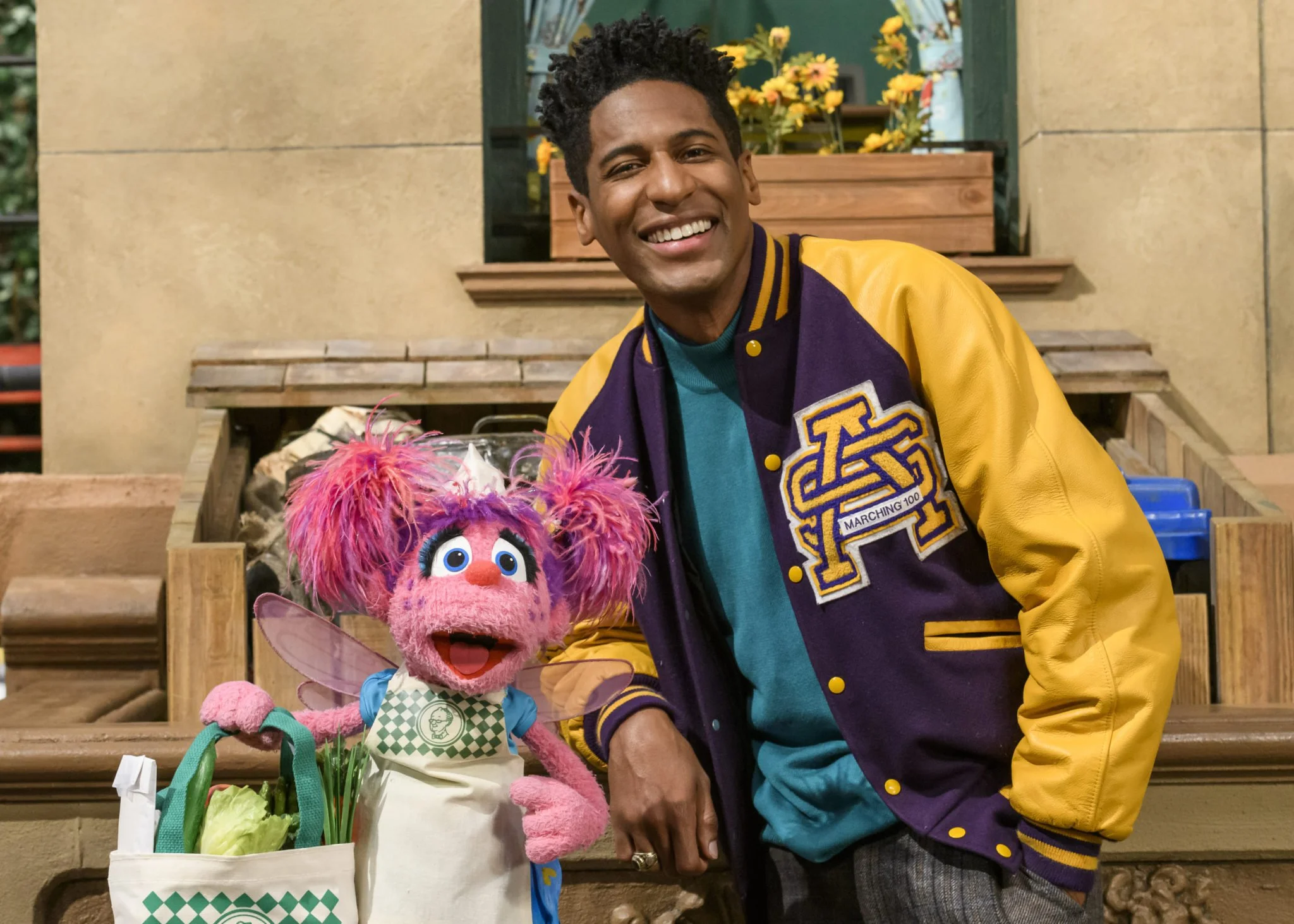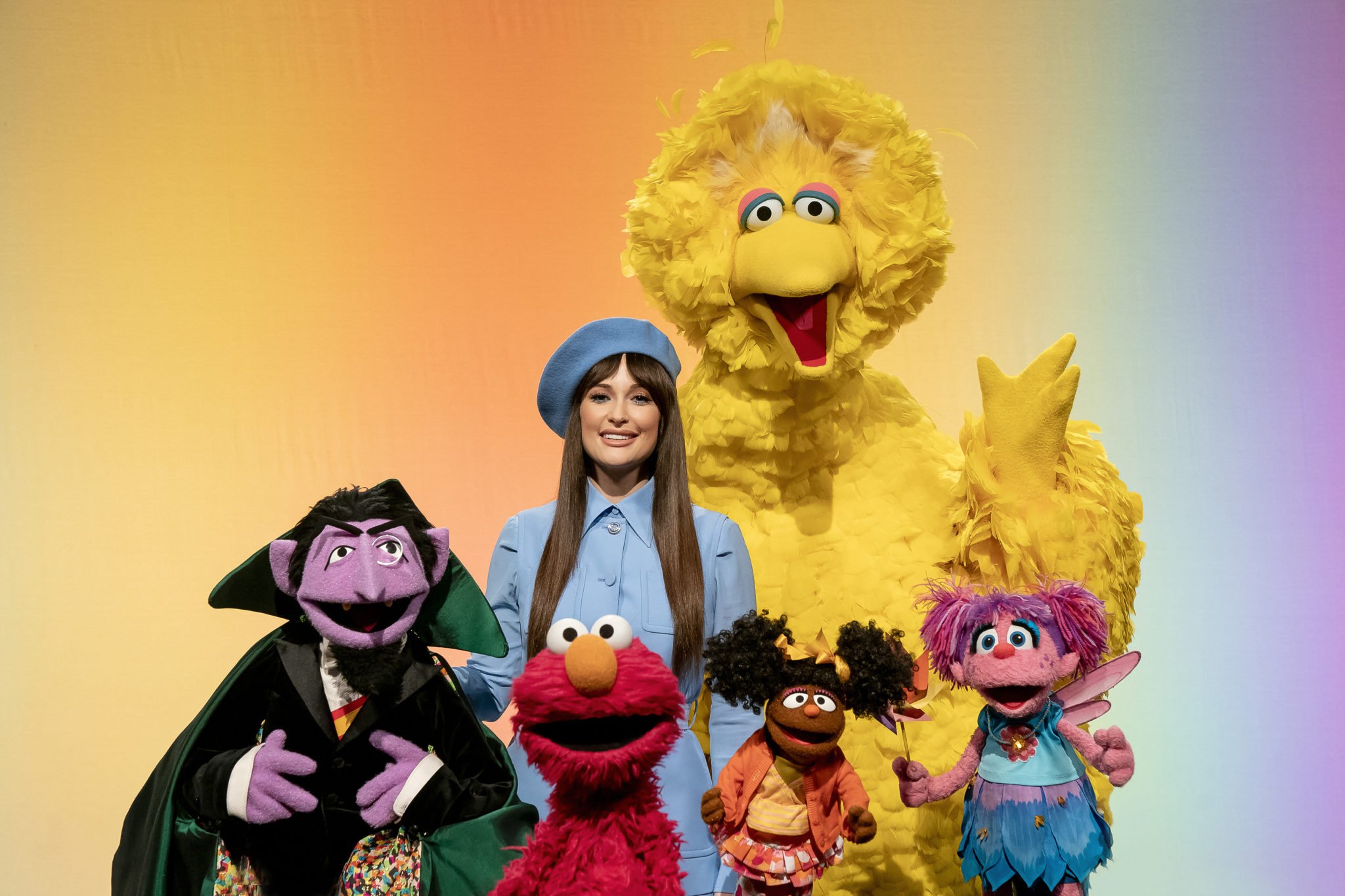Thank You For The Music, Sesame Street
Abby Cadabby and Jon Batiste. (Credit: Sesame Workshop, Richard Termine)
Having recently celebrated its 52nd birthday, Sesame Street continues entertaining and educating children with great guest artists.
By Gen Handley
The first word that ever came out of my toddler son’s mouth was “Daddy.” Okay, okay…this might be wishful thinking. His first utterance of the allegedly 30,000 words he will learn in his lifetime was actually “Elmo.” It was one of his earliest attempts at language and most importantly, his first acknowledgment of another soul in which there was instant affection when he laid his curious eyes on the bright-red, falsetto-singing monster, immediately accepting Elmo as a real person.
Sesame Street recently celebrated its 52nd birthday, announcing yet another season of engaging and entertaining children’s education through the relationships and songs of incredibly likeable live actors, influential artists and musicians, and of course, those transcendent singing characters like Elmo, who is back with a new puppy named Tango this season. These relationships are deeply rooted in music, and through the show’s well-written, interactive songs, that connection is also open to whoever is singing and dancing along, something significant in a child’s impressionable head and heart.
It’s this focus on music that has resulted in Sesame Street evolving into an almost generational curator of musical tastes that goes back to 1969 when the show first lit up living room television sets across the U.S. and, for some kids, a pivotal and positive introduction to the world of song. For more than five decades, the show has enlightened generations of kids—including myself and my little guy, Thomas—to an eclectic mix of genres, to artists and musicians of all backgrounds.
Jon Batiste is this season’s first musical guest on November 18th. The show made a strong impact on a young Jon Batiste who admits that his eyes welled up at one point, while on set, because he’s dreamt of appearing on the show for so long.
“It’s been a dream of mine since the beginning of my career…since I started being a performer,” Batiste tells SPIN about his appearance. “I was aware that it was a possibility in some realm, if I were ever to have enough success, I could be on Sesame Street. It’s always been a dream of mine.”
Kacey Musgraves and friends. Credit: Sesame Workshop, Richard Termine
Country singer-songwriter Kacey Musgraves also had a similar, moving experience when filming her episode, which is airing on December 2.
“There are few institutions more iconic than Sesame Street, and I’ve always adored how they blend music and learning,” says Musgraves. “It was a massive honor to be a guest on the show and something I’ll never forget. It made me kind of emotional to see behind the curtain of such a big part of my childhood.”
Sesame Street became an international institution and household name by focusing on education through catchy music and hilarious skits that not only engage its audience but also teach at the same time, leveraging the powerful, accessible medium of video to teach useful skills and lessons in a fun way that resonates with younger kids. The show’s music has also resonated with others in the industry and Sesame Street’s music has been recognized with 11 Grammys, the first in 1970 for Best Recording for Children for the Sesame Street Book and Record.
“[Sesame Street] is like a beam of light in the entertainment world,” says Batiste who is the amiable bandleader of the even-more-amiable Stay Human house band for the Late Show with Stephen Colbert. “Children’s media is something I’ve always been drawn to because of the purity of it. When you’re growing up, it’s an inspiration to be a better person. When you see it, you think, ‘I can be a better person’ if I have the agency to move towards self-improvement. I love that.”
While there have been a number of people instrumental in the show’s pioneering musical and educational content, it can all be credited to Joe Raposo, a composer and jazz pianist who wrote the show’s ubiquitous theme song, “Sunny Day.” Creating thousands of songs until his passing in 1989, Raposo set the bar high right off the bat with the now-legendary theme song as well as bringing impressive talent to its band like Chic guitarist Nile Rodgers, jazz harmonica pioneer Toots Thielemans for the theme song, as well as vocalist Grace Slick of Jefferson Airplane for a popular, psychedelic counting series. Over the decades, the bar remained high, hosting some of the most iconic names in the music industry on the show such as Stevie Wonder, Barbara Streisand, Paul Simon, Dizzy Gillespie, Johnny Cash, and Stevie Wonder all performing on an urban street called…well, you know.
As the current music director, Bill Sherman has filled those big shoes of Raposo and says this is a job he takes very seriously because of its everlasting influence on young people.
“I couldn’t be more proud,” says Sherman whose name you might recognize in the credits of the mega-musical Hamilton. “I hold this job in such high esteem that I always tell myself that if I’m not doing the best possible job then I should leave and go try to do something else. This job feels so important because it is so impactful…if you’re not giving it a hundred and fifty, two hundred, a million percent then you’re doing the job injustice because it is so important.”
Sherman has written more than 3,000 songs for the show and says he has an extremely rigid approval process when creating new music. It must receive the blessings of his nine and 11-year-old daughters.
“I play them most of the songs I write to see if they like them. They’re the best litmus there is…they’re very, very honest,” he says laughing. “And if later, I hear them humming or singing it at dinner, that one’s a success”
The show’s music goes deeper than teaching toddlers their ABCs. As the first mainstream children’s series to develop its music program and content around a structured curriculum and educational research, Sesame Street has been at the forefront of inclusivity, very recently welcoming their first Asian American character and addressing tough issues like race (Nina Simone sang “To Be Young, Gifted, and Black” in 1984), addiction, disability, and death (RIP Mr. Hooper – it still stings).
But even when raising some big issues that not many of us, young or old, want to talk about, Sesame Street manages to do so with a decorum that is rare and special which, Batiste says, is just as enchanting behind the scenes as well.
“When you step onto the set, it’s just a whole other level of…it’s like magical surrealism,” he says almost dreamily. “You step on the set and feel all of the emotions and the nostalgia that you had as a child and it’s like a wonderland.” He laughs. “I remember how I felt so spry and I felt like running and jumping all around the set.”
As my wife and I do our best to help Thomas navigate an unpredictable and sometimes-terrifying world, it’s reassuring to know that he and his little peers have that positivity, that accessible, mainstream moral compass to help them navigate some of the ups and downs of life, making that part of parenting a little easier, if not a guide for the parents themselves as well; Oscar the Grouch’s “I’m Sad Because I’m Happy” is feeling even more pertinent in my cynical adulthood. As a father, I am quite happy that one of his earliest COVID-era connections was with a fictional and friendly baby monster and that he can hum along to the legendary theme song. And as a music lover, I truly appreciate how this show is also providing a memorable soundtrack to the years that myself and his mom will value forever— that and I’ve learned to do a pretty mean Elmo Slide.
Read on Spin.com


